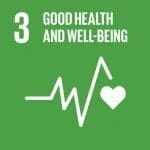By Sr. Margaret O’Dwyer, DC, along with the Daughters of Charity and Medical Coordinator of San Carlos Hospital, Altamirano, Chiapas, Mexico
The UN thrives on good examples of how the Sustainable Development Goals (SDGs) are being achieved in various parts of the world. The recent High Level Political Forum (HLPF) offered an opportunity to portray how the Daughters of Charity and staff at San Carlos Hospital in Altamirano, Chiapas, Mexico, are working on SDG 3—ensure healthy lives and promote well-being for all at all ages.
The Hospital’s ministry was presented, July 11, during an HLPF side event at the Permanent Mission of Ireland to the United Nations. Among speakers was Irish Ambassador, David Donoghue. The event was entitled, “Poverty to Prosperity: Shared Stories from NGOs Working with Local Communities. In addition to the Daughters of Charity work at San Carlos Hospital, there were discussions of efforts to serve Kenyan women suffering from fistulas, and various poverty-reducing projects in India.
“I was struck by how many of the SDG 3 targets San Carlos Hospital is addressing,” said Sr. Margaret O’Dwyer, DC, who participated on the panel. “Perhaps a nurse in Chiapas doesn’t say to herself, ‘Oh, I’m achieving SDG 3’ when she provides a vaccination. But the hospital’s efforts are clearly in keeping with many of the SDG 3 targets.”
The San Carlos staff is working to reduce maternal mortality and that of infants and children, provide access to essential health care services, address tuberculosis and other diseases such as Chagas, promote mental health and well-being, provide access to affordable medicines, and much more.
Chiapas is located in Southernmost Mexico, with a border on Guatemala. According to the National Institute of Statistics and Geography, Chiapas is the Mexican state with the highest rates of poverty (74.7%) and extreme poverty (46.7). Mortality rates from communicable diseases and lack of good nutrition are the highest in the country.
Altamirano is on the threshold of the jungles. San Carlos Hospital serves predominately indigenous people of the area. The Hospital began in an area devoid of health care, in 1969, by the Dominican Mission of the United States, in conjunction with Bishop Samuel Ruiz of San Cristobal de las Casas, Chiapas. In 1976, the Daughters of Charity took over the work and grew it according to the needs of the indigenous peoples.
San Carlos is a rural hospital that sometimes works as the only option for the sick, has 80 beds, of which 45 are for medical, surgical, or isolation patients; 15 are for obstetrical and gynecological patients; and 20 are pediatric beds. Approximately 15,000 patients are treated at the outpatient clinic each year, and about 2000 patients are hospitalized.
The Hospital serves a patient population that is 89 percent indigenous. Tzeltal is the primary indigenous community, followed by Tojolabal, Cho’ol and Tsotzil. The staff works hard to provide care in a culturally sensitive environment.
Many of the indigenous persons of the area are of scarce resources and this is the group upon which the hospital concentrates. Their land abounds in water, hardwoods, oil, and uranium. But the exploitation of resources by various groups perpetuates hunger and suffering because of displacement from their lands. Many live in remote areas with small patches of crops in mountainous settings. The Mexico Daily News reported in April, 2016, that 86 percent of the people living in Chiapas are below the food poverty line.
The indigenous population respects earth, life, air, sun, rain and water. (One might say they have a better innate understanding of Laudato Si than many….). Thus, the Hospital structure is well integrated with plants and trees. About 92 percent of the staff are indigenous, bilingual, or trilingual, which enhances the ability to communicate health care matters. In a culture which values the connection between body and spirit, the hospital also provides care which integrates science and the spiritual.

Photo Credit: sdgcompass.org
Over the years the hospital has promoted dignity among the people not only by treating them, but also by providing education about best health practices, such as boiling water, using latrines, and tending to personal hygiene.
San Carlos has a program for patients with tuberculosis which has achieved an 88 percent cure rate. Patients are financially supported in order to keep appointments for follow up treatments without being economically burdened.
Through another program, the hospital detects malnutrition, stunting, and wasting in children. Medical care is provided along with milk, corn, and soy supplements, as well as nutritional education for patents.
San Carlos Hospital was a pioneer in health services in the region. It is now not only a center for care, but also for employment. Thanks to the Hospital and other social movements, government is recognizing the need to provide more health clinics in remote regions.
The UN promotes getting to “the furthest behind first,” in terms of achieving the Sustainable Development Goals. San Carlos Hospital is an example of this practice.






0 Comments